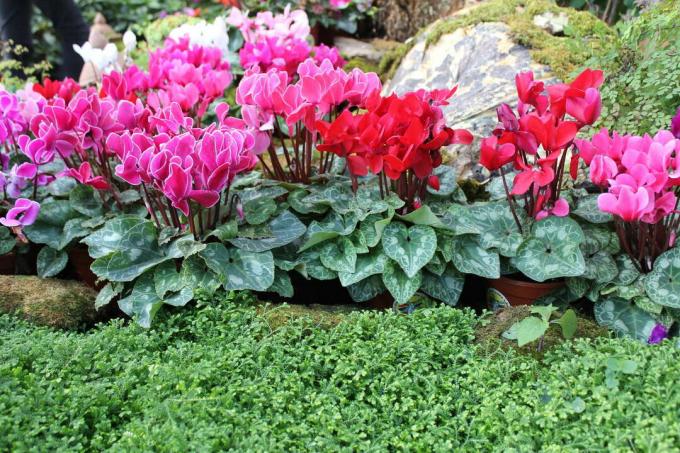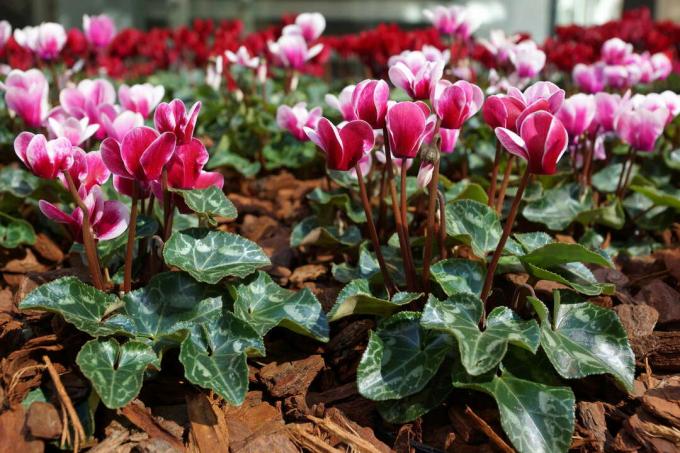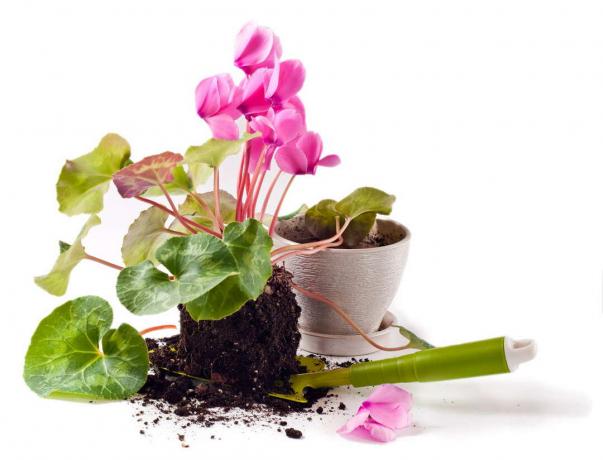The cyclamen is a popular ornamental plant for the home and the bed. However, there are a few things to consider for a lush bloom.

Cyclamen or cyclamen (Cyclamen) delight us both in the garden and in a cool spot in the house with their characteristic after flowers hanging below, their petals almost like the delicate wings of a brightly colored butterfly protrude. Depending on the species, the flowers, embedded in a nest of heart-shaped leaves, begin to flutter through our field of vision in winter or in summer. But in order for this aesthetic spectacle to present itself to you year after year, a great deal of sensitivity is required in the care of the primrose plants (Primulaceae), because especially when watering, cyclamen are real divas.
contents
- Cyclamen: origin and characteristics
- Cyclamen: Different types
- Cyclamen in the garden: the right location
- Cyclamen in the house and in the pot
-
Water and fertilize cyclamen properly
- Watering cyclamen
- Fertilize cyclamen
- Repot or transplant cyclamen
- Cyclamen: common diseases and yellow leaves
Cyclamen: origin and characteristics
Most of the species of this perennial flowering plant come from the Mediterranean region. Only one species has actually penetrated into the Alps, the European cyclamen (Cyclamen purpurascens) - the German name is also derived from this. Depending on the species, the plants bloom with the characteristic upward-pointing petals in winter until spring or in summer and autumn. Thanks to hard-working breeders, the flower colors now range from white to pink to purple. The cyclamen can also come up with warm orange and red tones and multi-colored flowers. Tubers are formed as persistence organs. These serve as an energy reserve for the plant, which can grow between 15 and 35 cm.
Cyclamen: Different types
There are around 22 different species of cyclamen. They have different distribution areas, different flowering times and differ in terms of the leaves and flower color. Common types are:
- The ivy-leaved cyclamen (Cyclamen hederifolium)
- The room cyclamen (Cyclamen persicum)
- The European cyclamen (Cyclamen purpurascens)
- The early spring cyclamen (Cyclamen coum)
- The curly-leaved cyclamen (Cyclamen repandum)

Everything you need to know about these Cyclamen species You will find here.
Cyclamen: As a perennial or for the apartment?
Whether perennial or living room depends on the species. The room cyclamen (Cyclamen persicum) is, as the name suggests, the choice for the pot in the living area. The species comes from Asia Minor, but came as early as the 17th Century to Europe. It is not hardy with us and therefore belongs in the house - at least in winter. Other species like the ivy-leaved cyclamen or the European cyclamen survive our wintry ones Temperatures without problems and can be planted in the garden, where they are in the most beautiful colors year after year bloom.
Cyclamen in the garden: the right location
Hardy cyclamen feel right at home in the garden. If you give them a nice spot in the shade to partial shade and embed their tubers in humus-rich, moist soil, they will spread all by themselves and form beautiful, dense clumps. Once you have found the ideal place for your cyclamen, proceed as follows to plant the tuber:
- Planting time: early summer or autumn
- Water the tuber
- remove weeds
- Planting hole: 5 - 7 cm deep
- Plant spacing: 10 cm
- Mix the excavated soil with compost
- Place the bottom of the tuber down in the planting hole
- Cover with soil and water well

Preferred cyclamen are usually planted out after flowering, when the leaves wither. However, the potted plants can also move into the bed during flowering. The flowering time depends on the species.
Cyclamen in the house and in the pot
Cyclamen bring color into the house when everything outside is dreary and dark. That is why they are popular houseplants. But the heating air, which offers us a pleasant warmth in winter, is not at all well tolerated by the plants. If you want to create a feel-good atmosphere for the early bloomers, choose the location and the pot according to the following criteria:
- Location: bright, but no direct sun
- Temperature: 12-15 ° C
- Soil: Well-drained potting soil
- Pot with a drainage hole

If you don't buy grown cyclamen in a pot, but rather plant tubers, about a third of the tubers protrude from the ground when you plant them. In summer, your cyclamen will look forward to a shady spot on the balcony or terrace. In winter, however, the plants should be in a protected, frost-free place.
Water and fertilize cyclamen properly
The correct care of the cyclamen is the guarantee that the plants do not get sick, because wrong watering makes the delicate flowering plants susceptible to fungal attack.
Watering cyclamen
Cyclamen need a lot of water, especially during the flowering period, the tuber must never dry out completely. However, waterlogging is absolutely not tolerated. That is why you need a little sure instinct and the right technique to find the golden mean. The pot is poured from below or with the immersion method. The top of the tuber must not get wet. When pouring from below, the coaster is emptied again after half an hour. The upper parts of the plant are not sprayed with water. The bed is watered after long periods of drought. But even after rain it should be checked whether the earth under the large leaves has gotten wet at all. In general, the following applies: It is poured when the upper layer of soil has dried out. More about the right technology and when it comes to the ideal time Watering cyclamen You will find here.

Fertilize cyclamen
When fertilizing cyclamen, the right timing is required so that you can use the nutrients to maximize the flowering time. For this purpose, liquid fertilizer is used in the irrigation water during the growth phase. In the following intervals:
- Pot: Every 2 - 4 weeks
- Bed: every 2 - 3 months
It is best to use an organic fertilizer. This has not been industrially reconditioned and is therefore more environmentally and resource-friendly. The plants also benefit, because the nutrients are available for a longer period and soil life is improved. Our Plantura Organic flower & balcony fertilizer is a purely organic organic liquid fertilizer that is simply administered via the irrigation water. Immediately after flowering, there is no fertilization for a period of eight weeks. Because the tubers need a certain rest period. As an alternative to regular fertilization, the bed can be mulched with compost once in autumn.
Repot or transplant cyclamen
Repotting or transplanting is not absolutely necessary, but can of course be done if desired. Let your plant move six to eight weeks after the flowering period ends. At this point in time, the first new shoots should have formed. Then it goes to implementation as follows:
- Dig up the tuber
- Water the tuber and remove the soil
- Remove injured and dead roots
- Divide the tuber (if necessary)
- Plant the tuber as described above

Remember to let the bulb of a potted cyclamen protrude about a third out of the ground. When repotting, the new pot should be about 5 cm larger than the old one.
Cyclamen: common diseases and yellow leaves
When properly cared for, cyclamen stay healthy. If diseases occur, it is very likely that the water was poured incorrectly. The most common diseases are listed here:
Gray mold
- Characteristic: gray, mold-like coating on the leaves
- Reason: Too warm location, too moist soil
- Countermeasure: Repotting, adapting location and watering
Tuber rot
- Features: tuber rot
- Reason: Too moist soil, withered leaves
- Countermeasure: None, so it is essential to take precautionary measures
Cyclamen wilt
- Characteristics: wilting and yellowing symptoms, brownish or reddish necroses within the tuber
- Reason: poor substrate quality, soil pH too low, stress
- Countermeasure: None, so it is essential to take precautionary measures

There are also pests that love to attack your cyclamen.
Vine weevil
- Features: feeding spots on the leaves
- Countermeasure: collect at night, rinse roots and repot
Cyclamen mite
- Characteristics: eating of the shoot tips, misshapen leaves and flowers (adults); Feeding on tuber and roots (larva)
- Countermeasures: Rinse and repot roots
If the leaves of your cyclamen turn yellow, this is usually not due to a disease, but rather to incorrect care. Most of the time it is not poured properly here. How and how often you Watering cyclamen should learn from this article.
